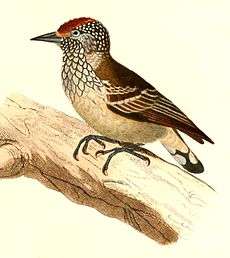White-wedged piculet
The white-wedged piculet (Picumnus albosquamatus) is a species of bird in the family Picidae. It is found in Bolivia, Brazil and Paraguay, where its natural habitats are subtropical or tropical dry forests, subtropical or tropical moist lowland forests, and dry savannah. It hybridizes with the white-barred piculet where their ranges overlap.[2]
| White-wedged piculet | |
|---|---|
| Male at Bonito, Mato Grosso do Sul State, Brazil | |
| Scientific classification | |
| Kingdom: | Animalia |
| Phylum: | Chordata |
| Class: | Aves |
| Order: | Piciformes |
| Family: | Picidae |
| Genus: | Picumnus |
| Species: | P. albosquamatus |
| Binomial name | |
| Picumnus albosquamatus D'Orbigny, 1840 | |
Description

The species grows to a length of 10 to 11 cm (3.9 to 4.3 in) and is rather variable in appearance. The male has a red fore-crown while the female has a brown or black crown. The upper parts of head and body are olive brown with white speckling, especially on the mantle. The wings are brown above, with pale edgings to the secondaries and tertiaries, and the tail is brown, the two central feathers being white, and there being a white patch on the outer edge near the tip. The throat, breast and belly are white with black scaling, the flanks and lower belly being less scaled than elsewhere. The iris is brown, the beak blackish and the legs grey. The juvenile is similar to the female but has a paler crown.[3]
Distribution and habitat
The native range of the white-wedged piculet in tropical South America includes parts of Bolivia, southern Brazil and northern Paraguay; it is common in the Pantanal region. It is non-migratory and is found at altitudes of up to 2,100 m (6,900 ft). It occupies both moist lowland and upland deciduous forest, and sparsely-wooded, drier savannah country, thickets and cerrado.[3]
Ecology
This bird has been little studied, but like other members of the genus it is likely to feed on insects and other small invertebrates which it garners from trees. It breeds in holes and crevices in trees; one hole was about 3 cm (1.2 in) in diameter. The exact breeding season is unknown, but juveniles have been observed between May and December.[4]
Status
P. albosquamatus has a very wide range and is fairly common. The population appears to be stable, and the International Union for Conservation of Nature has assessed its conservation status as being of least concern.[1]
References
- BirdLife International (2016). "Picumnus albosquamatus". IUCN Red List of Threatened Species. 2016: e.T22680753A92876067. doi:10.2305/IUCN.UK.2016-3.RLTS.T22680753A92876067.en.
- McCarthy, Eugene M. (2006). Handbook of Avian Hybrids of the World. Oxford University Press, USA. p. 108. ISBN 978-0-19-518323-8.
- Gorman, Gerard (2014). Woodpeckers of the World: A Photographic Guide. Firefly Books. pp. 72–73. ISBN 177085309X.
- Winkler, H.; Christie, D.A.; Bonan, A.; Boesman, P. "White-wedged Piculet (Picumnus albosquamatus)". Handbook of the Birds of the World Alive. Lynx Edicions, Barcelona. Retrieved 20 April 2017.CS1 maint: multiple names: authors list (link)
